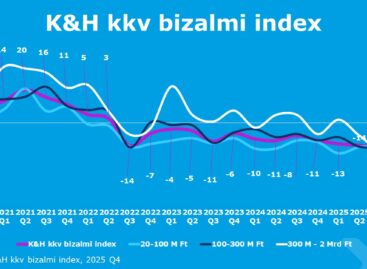The forecast of GKI Economic Research Co. for 2015
Economic trends in 2014 seem to be somewhat better than expected in September in quantitative terms but they are not different in genuine qualitative ones. However, with intensifying global economic and political risks as well as Hungary’s deteriorating assessment by international economic participants, trends in 2015 seem to be more uncertain. GKI forecasts Hungary’s GDP to grow by 3.2 per cent in 2014 and 2 per cent in 2015.
The world economy in general and the EU in particular are expected to grow at a slower rate than projected earlier, economic expectations in Europe are deteriorating slightly. At the same time the marked fall of crude oil prices in which the US-Russia confrontation is an important factor is a favourable development. Nonetheless, uncertainty concerning natural gas deliveries is rather significant.
Following stagnation last year, GDP is projected to grow by 1.3 per cent in 2014 and 1.5 per cent in 2015 in the EU and by 0.8 per cent and 1.1 per cent, respectively in the euro area. GDP growth in Germany (2014: 1.3 per cent; 2015: 1.1 per cent showing slowingdown) is hardly better than in the euro area. In the US the Fed finished quantitative easing, but the rise of its reference rate is not expected until mid-2015. The reference rate of the European Central Bank is only 0.05 per cent; it is expected to remain unchanged in 2015. In addition, the ECB started quantitative easing in order to boost the economy; the European Commission announced an investment plan whose implementation is still uncertain. Whereas in the EU expectations were slightly deteriorating, in Hungary they reached peak levels presumably due to the parliamentary elections held in the spring of 2014. In November the GKI-Erste economic sentiment index dropped slightly compared to October, business expectations remained unchanged but consumer sentiment became worse.
The budget envisaged for 2015 reflects well the economic policy of the government. The overall objective is to reduce the general government deficit below 3 per cent of GDP at any price and to avoid the resumption of the excessive deficit procedure in order to get access to EU transfers. The tools applied to achieve this objective indicate that this objective can be interpreted only in the context of power politics (such as the reorganisation of ownership relations). In the taxation of personal incomes a flat tax rate is being applied, which is unprecedented by international standards, whereas in the corporate sphere the tax system differentiates not only among industries, but even within them progressive tax rates are effective (e.g., in the retail trade of fast moving consumption goods, the tobacco and the advertisement market). This leads to market distortion and unfair competition. Regarding general government expenditures, the reform of large redistribution systems based on objective criteria is missing. Thus, any cut in expenditures is perceived as austerity rather than transformation causing much harm to the educational and the healthcare system.
In 2015 the rate of increase in gross wages will be similar to that accomplished in 2014. Nevertheless, the minimum wage is likely to grow at a rate (maximum by 2 per cent in contrast to the 3.6 per cent figure of this year) close to the inflation rate anticipated by the government (1.8 per cent). Nevertheless, GKI forecasts the rate of inflation to go up from 0 per cent this year to 2 per cent in 2015. Under these circumstances earnings and real incomes will nearly stagnate (they will be up by 1 per cent and 0.5 per cent, respectively). Consumption is projected to grow by 1-1.5 per cent, more or less at the same rate as this year. The fall in the burden of FX debtors, too, will play a role in it. Households will remain net repayers of loans.
Regarding the accumulation of gross fixed assets, expansion is not on the horizon in either the public sector or the private sphere. Therefore, following the 13 per cent increase in 2014, stagnation is most likely in 2015. The inflow of EU transfers is expected to decrease in 2015. There is a quite significant risk that in spite of the efforts made by the government, 5-8 per cent of the transfers valued at HUF400bn-HUF800bn will be frozen in the system. The National Bank of Hungary is set to bolster economic growth by its low reference rate, its Funding for Growth Program and the establishment of an asset management institution aiming at the purchase of frozen commercial real estates (“bad bank”). Due to sluggish domestic demand, uncertainties in the investment climate including the interventions of the government, the reorganisation of markets, nationalisations through acquisitions of private assets and the extension of differentiated tax rates as well as due to the questionable
2
return of projects from the point of view of banks and the stifling of the banking system, the general propensity to invest and save is modest. Foreign capital is leaving Hungary; and because of the lack of legal certainty the major part of domestic capital, too, is waiting on the side-lines.
Following the record achieved in the second quarter of 2014, the slowdown of GDP growth that had been predicted by GKI started in the third quarter. The effects contributing to dynamic GDP growth such as favourable European business cycle, surge in investments financed by EU funding and reduction of overheads entailing increasing purchasing power are fading away. In addition, international political and economic uncertainties are intensifying, and the assessment of Hungary by international economic participants is deteriorating further due to the government’s economic policy characterised by nationalisations through acquisitions, anti-market measures and suspected corruption. Hungary’s GDP is forecast to grow by 3.2 per cent in 2014 and 2 per cent in 2015. Although the latter figure is still higher than that of the EU totalling 1.5 per cent, but this is the result of modest acceleration in the EU and deceleration in Hungary. They are opposite trends; in 2016 GDP is expected to grow by 2 per cent in the EU and only 1.7 per cent in Hungary. Hungary’s GDP growth rate is likely to lag behind that of the EU.
With the slowdown of both external and internal demand, the growth rate of almost all industries is set to decelerate. Nevertheless, decline is predicted only in finances, whereas in the real estate sector minor increase is anticipated. Industry is likely to grow most sharply, the growth rate of construction is set to plummet but it will still be higher than the average. In retail trade strong government intervention in market trends will not reorganise significantly the market structure, although it will downgrade the sector and trigger price increases. Although foreign trade turnover will rise slightly in 2014, it will be the first time after four years that the expansion of the volume of imports will exceed that of exports. With uncertain European recovery and the inclusion of the impact of car manufacturing investments in the statistical base, the growth rate of both exports and imports is set to decelerate in volume terms in 2015, however, the deceleration of the latter will be more pronounced. In 2014 and 2015 the contraction of GDP produced by the financial sector and the loan stock will continue, there will be no profits and solvency capital will have to be raised. With the buy-out of MKB Bank and Budapest Bank by the government, the share of Hungarian ownership exceeds 50 per cent in the equity capital of the banking system. Nevertheless, the advantages of national ownership are not obvious, whereas the risks are rather pronounced. The major danger of the state-owned banking system is that in the absence of independent control, subjective factors play an important role in lending, and this makes the functioning of the banking system more risky; in case of tensions they need capital injection by the state. The “bad bank”, too, may give a chance to utilise the assets that are collaterals of these loans according to “special” objectives e.g. when they are sold to selected clients.
In 2014 employment is increasing spectacularly by 5 per cent and the unemployment rate is decreasing from 10.2 per cent in 2013 to 7.8 per cent. Nevertheless, these figures are misleading. The growth rate in the number of genuine employees (working in Hungary and excluding public workfare schemes) is significantly smaller than that pointed out by statistics. In 2015 employment is likely to go up by 1 per cent, and unemployment is forecast to total 7.5 per cent due to the further expansion of public workfare schemes and the almost complete termination of social support.
According to the forecast of GKI, the general government deficit relative to GDP will be below 3 per cent in 2014 and 2.4 per cent in 2015, in line with the plans of the government, although not exactly according to trends enshrined in the budget law. Even a smaller deficit requested by the EU and financial investors may probably be reached by measures to be introduced during the year. In 2015 primary general government revenues (such as the value added tax) may be about HUF200 billion smaller than envisaged (including the fallout caused by the decline of gasoline prices). The source of a revenue item related to the sale of state-owned assets valued at HUF169 billion is unclear. Uncertainty associated with the revenue side totals altogether some HUF370 billion. At the same time, unfortunately savings are also expected in general government expenditures due to the smaller than planned amount of EU transfers, since own contributions of the public sector will necessarily be smaller as well. The other expenditure items of the general government are underestimated (e.g., in healthcare and public education). The EU may reclaim the funds already paid in some areas subject to competition law issues and suspected corruption or it may impose fines on the Hungarian government. Thus, an overall saving valued at HUF20 billion can be reckoned with in general government expenditures. This implies that in addition to the planned general government deficit of HUF877 billion, additional uncertain items in the value of HUF350 billion (amounting to 1 per cent of GDP) can be identified. The so called Country Defence Fund contains only HUF30 billion. Without corrections to be taken during the year and with the freeze of the Country Defence Fund, there is
3
the real risk of the increase in the deficit amounting to 1 per cent of GDP. In order to avoid the rise of the general government deficit, additional measures will have to be taken during the year that will have another negative impact on the conditions of GDP growth. There is no reason to assume that the quality of the corrective measures will be better than that of the compilation of the general government.
EU institutions have already indicated in three reports this year that Hungary’s government debt trajectory is not credible and the resumption of the excessive deficit procedure based on the renewed legal rules concerning government debt cannot be excluded even if the general government deficit remains below 3 per cent of GDP. Hungary should reduce the government debt rate by 1 percentage point per annum in the average of 3 years, and in the transitory period lasting to 2016 it should reach an appropriately low level (or decrease) of the structural deficit. (According to the rule, following the termination of the excessive deficit procedure, Hungary should achieve its medium-term general government objective, more precisely the structural deficit target defined as 1.7 per cent of GDP in 3 years, i.e. until 2016.) While checking this, EU institutions consider the balanced approximation of the objectives. After this monitoring process the one-twenty rule becomes effective according to which the share of general government deficit above 60 per cent of GDP should be reduced by one-twenties per annum. In the case of Hungary this figure is 1 percentage point of GDP. Figures related to the reduction of government debt presented by the government and approved by the Budget Council foresee an improvement of 0.9 percentage points of GDP in 2015. However, this corresponds to the Hungarian government debt rule rather than the rules enshrined in the Treaty of Maastricht. The Hungarian government calculated the government debt denominated in foreign exchange at the exchange rate of the end of the preceding year. According to the forecast of GKI, the exchange rate of the forint to the euro will weaken by HUF12 in 2015 amounting to HUF320. According to the National Bank of Hungary the weakening of the exchange rate of the forint to the euro by HUF10 leads to the increase of the government debt ratio by 1.1 percentage points. Therefore, the genuine government debt ratio as defined and monitored by international institutions will mount even if the budgetary objectives are achieved in 2015. In addition, the forecast of the European Commission published early November this year predicted unchanged and rather high structural deficit totalling 2.8 per cent of GDP in 2015 that exceeds by 1.2 percentage points the 1.6 per cent objective of the government. Therefore, in the spring of 2015 the resumption of the excessive deficit procedure may be put on the agenda again or in order to avoid this, the Hungarian government will have to introduce additional measures in the course of the year.
At present and next December, temporary cut in the treasury reserve and the sharp strengthening of the exchange rate of the forint to the euro make the reduction of the government debt ratio possible. However, it is doubtful whether this practise of the previous years could be repeated. The government can improve the situation if it uses the remaining part of the nationalized assets of private pension funds amounting to HUF200 billion for the reduction of the government debt. (In addition to hurting legal certainty and the rule of law, the nationalization implies the eating up of the future.) Another option is to pay the enormous gains of the National Bank of Hungary deriving from the weakening of the exchange rate of the forint into the budget and use them for the reduction of the government debt. In contrast to the first option this one is in line with the principles of the rule of law and market economy.
The external balance is in surplus, but its size is expected to decrease in 2015. In 2014 the deterioration of the foreign trade balance was neutralized by the inflow of EU transfers serving investment purposes. In 2015 the inflow of net EU transfers will diminish to EUR2 billion from EUR4 billion in 2014. This drop will not be compensated for by the increase in the foreign trade surplus. In 2014 inflation ceased to exist temporarily, although the reduced reference rate of the National Bank of Hungary representing 2.1 per cent and the weakening of the forint by 3.5 per cent per annum in average have inflationary impacts. The disappearance of inflation was enabled by the very small increase in global price indices, but the determining role could be attributed to the unsustainable elements of overhead reduction accomplished by the government. Due to the particularly low statistical base, prices set to increase somewhat in the last month of the year. With the fading away of the overhead reduction and the increase of taxes this trend will be at work in the course of 2015. At the same time, amidst the decrease or plummet of global energy prices and favourable import price trends, the need to correct the overhead reduction policy in the long run softens up, although energy service providers are still producing losses. Therefore, in 2015 the inflation rate is likely to total some 2 per cent. The central bank is likely to make efforts to hold the reference rate unchanged and in order to achieve this objective it will most probably tolerate the weakening of the exchange rate of the forint to the euro in the average of the year to even HUF320.
Related news
Related news
Shrinkage inflation: several products became smaller in December and January – baked goods, sweets, razor blades, and dishwashing detergent were also affected
🎧 Hallgasd a cikket: Lejátszás Szünet Folytatás Leállítás Nyelv: Auto…
Read more >Research: There was no “alcohol wave” during Covid, but consumption increased among a narrow group
🎧 Hallgasd a cikket: Lejátszás Szünet Folytatás Leállítás Nyelv: Auto…
Read more >The mood of Hungarian SMEs has improved dramatically
🎧 Hallgasd a cikket: Lejátszás Szünet Folytatás Leállítás Nyelv: Auto…
Read more >





